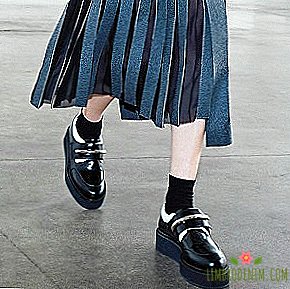World Conspiracy: What's Behind the Fast Fashion
With the advent of the mass market, life has become easier: affordable and fashionable clothes can now be bought at home or lying on the sofa. No need to save and worry that the thing will deteriorate: the prices and the range allow you to replace it with exactly the same or even better. It would seem that there can be more beautiful - after all, the fresh trends of the fashion world are told to us almost the next day. If we do not admire the huge machine called “fast fashion,” we blindly support, without thinking about the mechanisms inside it.

How fashion has become available to all
For centuries, fashion was the pleasure of the so-called elites - the individual segments of the society were simply not affordable for the poor. The appearance of clothes up to the 17th century was even regulated by law: in Europe it was generally forbidden for the poor to imitate the clothes of the rich. Some kind of erosion of the boundaries between strata of society occurred only in the XIX century with the industrial revolution. There was a new rhythm of life, where there was a place for both free time and new interests - after all, now the workers had a normalized schedule, weekends and holidays. So, for playing sports and going to the beach, the usual clothes turned out to be inconvenient. Corsets and long skirts are outdated, and the issue of fashion diversity has become an edge.
Coco Chanel was the first to introduce it in the 1920s: she suggested wearing simple and functional clothes by launching prêt-à-porter collections, that is, with models in several sizes and ready to wear. As the Norwegian anthropologist and journalist Marie Grinde Arntzen notes in the book "Dress-code. The Ugly Truth about Fashion", it was thanks to Chanel that individual tailoring began to give way to factory production.
In the 60s there was a youth revolution. People needed new and affordable clothing that reflected the rebellious spirit of the times. Shops decided to adjust: short skirts, unisex T-shirts, velvet dresses and jack boots appeared, which did not suit the older and more conservative generation. The course was taken on the cheap fashion available to those who earned during the breaks from their studies.


It’s a paradox, but over time we spend less and at the same time buy more. If in the 60s-80s about four thousand dollars a year were spent on clothes, today there are about one and a half thousand. The real flowering of cheap fashion occurred precisely at zero: from the 90s, prices fell by half, and the number of purchases every year began to increase four times. The philosophy of the mass market, which conquered the market, is extremely simple: to make fashion, shown on the catwalks, accessible to all. Brands copied the latest trends and tried to deliver them to customers as soon as possible, and the latter met this idea with delight.
The first to introduce the concept of fast fashion was Topshop - it produced one collection in six weeks. The Swedish H & M network followed him: the clothes went on sale for three weeks, and twenty new points were opened in the United States alone a year - judging by the figure that is spoken in the documentary The Real Price of Fashion, today the company earns about 18 billion in year. But the undisputed leader to this day remains the Spanish Zara: 200 designers develop about 40 thousand new models a year, 12 thousand of which are actually produced. To interest the buyer and inspire that he may not get things, each collection is limited. Ostromodnaya model a week after admission to the store can be sold out completely. This principle of spurring demand still works.

How fashion affects the planet and people
"Do you want to change outfits four times a day, like the Hadid sisters do? And wear bulky sneakers from both the Vetements and Swear collaboration, which will be available in six months?" - about such spells mass market attracts new buyers. And it stirs interest, constantly changing the assortment: as a result, two seasons - spring-summer and autumn-winter - stretch by fifty-two.
To be affordable, clothes should not be expensive, so companies are trying by any means to reduce the cost of goods. For example, choosing low-quality fabric. The more you buy, the more often you get rid of things and buy again: only in 2015 every American threw on average thirty kilograms of textiles. Only residents of New York have about 200 thousand tons of clothing annually, which is comparable with 72 Olympic swimming pools with water. And in Great Britain alone, the total weight of clothes purchased annually is 1.72 million tons. Imagine at the same time that all these things are made of synthetic materials that have been decomposed for hundreds of years - we have already told about the irreversible consequences of textile production.


The cost of things is reduced and at the expense of cheap production. It is possible in countries where, in principle, little is paid for labor: Bangladesh, Cambodia, India, China. Factory workers in these countries receive from one to three dollars a day, thus ensuring the whole family. Needless to say, they have to work under difficult conditions: a working day can take up to fifteen hours and even overnight - factories are locked together with people to fulfill an order on time. Buildings are often in disrepair, causing them to collapse or burn. So, in April 2013, in the district of Dacca, the eight-story Rana Plaza complex collapsed, which housed five sewing factories. 1135 people died, more than two thousand wounded.
As director Andrew Morgan tells in "The real price of fashion", the management simply waved away complaints from the workers that the building had gone cracked. According to Morgan, fashion brands hire people informally and do not own factories. As a result, receiving huge profits for the hard work of employees, companies do not bear any responsibility. But the governments of the countries cannot refuse orders: only Bangladesh, thanks to exports, earns 28 billion dollars a year. Moreover, they deliberately keep wages low in order to offer the customer the best price. The market giants, however, could no longer shut their eyes to the problem after the scandal that followed the tragedy. Independent experts who conducted a study in 2017 noticed that many of them have significantly improved working conditions for workers — although there is certainly room for growth.

Victims or accomplices
The Guardian journalist Lucy Sigle tells a story about a girl who once came out of a famous British mass market with five to six packs of clothes. It was pouring rain, and before she could move away from the store, the handles of one of the bags broke off — folded clothes fell on the sidewalk. What was the surprise of the observers when the girl went further, even without collecting the purchases.
At the other end of the planet, one of the heroines of Morgan calls: "Think that all this is sewn with our blood." Yes, the mass market constantly instills that we need new things in order to sell more, but let's be honest - customers like to stay in the illusion. Rejection of it means rejection of the joy that gives the purchase - albeit very fleeting. The cabinets are haphazardly filled with clothes that cannot be combined with each other, and again we have nothing to wear. Contrary to the belief that shopping makes a person happier, numerous studies prove the opposite: the more people focus on material values - image, status, money - the more they are prone to depression and anxiety.
Future fast fashion
In this vicious circle, everyone needs something of their own: corporations are hungry for profits, poor countries for orders to keep the national economy afloat, and buyers for a fleeting sense of satisfaction. The mass market is quickly catching new trends, whether it is a concern for the environment or a variety of beauty. The illusion continues to live, so hardly anyone voluntarily leaves the endless chain.
The author of the article "Fast fashion sold under the guise of green?" gives an example: Zara, H & M and other brands began to produce "conscious" clothing and opened reception centers for worn-out clothes - it will be used for processing or charity. Handing over old things, you get a discount on new ones - that is, a reason to return to the store and buy something again. Recycling non-natural clothing is almost as harmful as its production - due to chemicals and synthetic fibers that get into the water. Charity also hides many pitfalls: too spoiled or dirty clothes are simply thrown away. The United States, for example, sends donated items to Africa or Haiti, where they are sold in markets and thus undermine local production. Or thrown away, because they do not fit the local climate.
If consumers take a course on conscious consumption, fast fashion will still live: it's hard to imagine companies consciously losing money. Some enthusiasts, in order to break the vicious circle, propose to change the philosophy of the system: shops can sell not the same and cheap clothes, but “experience”. Make sure that every thing has aesthetics or history behind - today it’s really the one that is becoming important for the younger generation of consumers, and not the ability to carry endless copies.
Photo:Topshop, Zara, Mango, Uniqlo x J.W.Anderson, H & M





